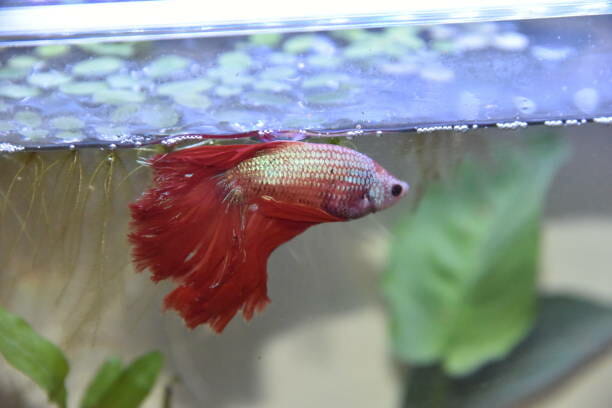Why Do Betta Fish Swim Sideways: Causes, Treatment & Care Tips
Betta fish are popular as pets because they are so easy to care for. They require little to no special care and are very active fish that enjoy swimming in circles. However, in some cases, you might notice that your betta fish is swimming sideways and this could be alarming.
There could be a few reasons why a betta fish is swimming sideways. One possibility is that the fish is sick with a swim bladder disease and needs to be treated. Another possibility is that the fish is trying to escape from its surroundings. If the fish is swimming sideways and it seems to be distressed, it might be best to bring it into a tank with more plants and decorations so that it has more space to swim around.

Table of Contents
What Is Swim Bladder Disease?
Swim bladder disease is a condition where the fish’s swim bladder doesn’t function correctly. This can cause problems with breathing and digestion, as well as an inability to stay swimming properly underwater for long periods. If you notice that your betta fish is swimming in a sideways pattern or isn’t able to stay underwater for very long, it might be worth bringing it to see a veterinarian.
Causes of Swim Bladder Disease
There is no one definitive cause of swim bladder disease, but it can be caused by several factors. Some common causes include:
Overfeeding and Constipation
Overfeeding of betta fish and constipation can both cause swim bladder disease in bettas. Overfeeding leads to an accumulation of fluid in the fish’s body, including in the lungs. This causes difficulty breathing and may progress to swim bladder disease. Constipation can lead to a blockage of the fish’s intestines, which can also cause swim bladder disease.
Unstable Water Temperature
The low temperature of the tank water can also cause swim bladder disease. The cold temperatures cause nerves to freeze, which may lead to swim bladder problems.
Stress and Shock
Shock can also cause swim bladder disease. Swim bladder problems may develop after a fish is subjected to extreme stress, such as being transferred from freshwater to saltwater or being kept in an overcrowded tank.
Infection
Bacterial and parasitic infections are common and can be very unpleasant. They can lead to several different health problems, and can even be fatal. Bacterial infections are usually caused by bacteria, while parasitic infections are usually caused by parasites. Both types of infection can be treated with antibiotics, but both can also be prevented through good hygiene practices.
Chronic Injury
Chronic injury to the fish’s body can also lead to swim bladder problems. This includes injuries caused by other fish, falling objects, and rough play in the tank.
Nerve Damage
Nerve damage, either from infection or injury, can also cause swim bladder disease. This type of damage can occur anywhere in the fish’s body and may be difficult to detect. Once nerve damage has occurred, it is often difficult to treat.

Symptoms of Swim Bladder Disease in Betta Fish
Betta fish are known for their beautiful, colorful scales and their friendly personalities. However, some owners soon find out that Bettas also have a swim bladder, which is an organ located just below their stomach. Swim bladder disease is a common problem in Bettas, and it can cause several symptoms.
Swim bladder disease can cause several problems for Bettas. The most common symptom is a fish that constantly swims sideways around in its tank or aquarium. This can be frustrating for the owner, as the fish cannot be left alone and must be watched constantly. Swim bladder disease can also cause a fish to become bloated and unable to eat. In severe cases, swim bladder disease can even cause the fish to die.
Symptoms From Unhealthy Diet and Constipation
Swim bladder disease can often be the result of overfeeding or constipation. When these problems are not treated, they can cause a fish’s swim bladder to become enlarged and unsupported. This makes it difficult for the fish to swim and breathe properly, and eventually, it may die as a result.
Symptoms From Bacterial and Parasite Attacks
Bacterial and parasite attacks can also cause swim bladder disease in Bettas. When these problems are not treated, they can lead to the fish’s intestines being blocked. ̴Bacterial infections can lead to constipation, which reduces the amount of oxygen in the fish’s body. ̴Parasites will also reduce a Betta fish’s ability to breathe and eat properly. Both bacterial and parasitic infections are very common for bettas since they find it so challenging to defend themselves from such attacks and are therefore often infected with disease-carrying bacteria or parasites that allow these diseases access into their bodies.
How to Take Care of Betta With Swim Bladder Disease?
Chronic swim bladder disease is a condition that can affect bettas and other fish. Bettas with chronic swim bladder disease may experience difficulty breathing, due to the accumulation of fluid in the fish’s lungs. Bettas with chronic swim bladder disease may also experience problems eating, due to the obstruction of their throats. Treatment for chronic swim bladder disease typically involves surgery to remove the affected organs.
Other steps you can do to help your sick betta include:
- Provide a warm, dry place to rest, this is especially important if your betta is sick with a respiratory infection, as they may not be able to tolerate cold temperatures.
- Provide food and water in plenty.
- Make sure the food and water are fresh and clean.
- Keep the tank clean. Make sure to keep the tank clean and free of debris.
- Provide a humidifier. If your betta is sick with a respiratory infection, he or she may need extra humidity to help ease the symptoms.
How to Treat Betta Fish With Swim Bladder Disease?
If you have a sick betta fish, the first step is to take him or her to a veterinarian. This will allow the vet to determine the exact condition of your betta and provide the best possible treatment. Treatment options may include antibiotics and pain killers. If necessary, your veterinarian may also recommend antifreeze or another type of medication.
Medications for Swim Bladder Disease
There are a few types of betta fish medications that you may need to provide for your sick betta. These include antibiotics, antifreeze, and pain killers. However, the type and dosage of medication will depend on the specific condition your betta is experiencing. Always consult with a veterinarian if you have any questions about treating your sick betta fish.
Do Bettas Recover From Swim Bladder Disorder?
Most betta fish recover from swim bladder disorder with a few weeks of treatment. However, some may need surgery to remove the affected organs. In either case, regular vet check-ups will be necessary to monitor your pet’s progress and ensure that the condition does not return.
In addition, you may also want to take your betta fish to a vet when he or she starts acting lethargic and experiencing a drop in energy.
Can Swim Bladder Disorder Spread?
Swim bladder disorder can spread from one betta fish to another. If you have several sick betta fish in your home, it is important to take them all to the vet for diagnosis and treatment. This will help prevent any further spread of the disease.
Is Swim Bladder Disease Fatal?
Although swim bladder disorder is not typically fatal, it can be a serious condition that requires immediate veterinary attention. If left untreated, swim bladder disease may lead to the loss of one or more organs in your betta fish’s body.
Other Causes and Treatments of Betta Fish Swimming Sideways
Fungal Infection
There are a few types of fungal infections that can ail bettas. When treating your fish for fungus infection, it is important to use the correct medication and dose. Additionally, keeping your aquarium clean will help reduce the chances of spreading the disease to other members of your aquatic family.
Tail or Fin Rot
Tail or fin rot is a condition that can affect your betta’s body and fins. When treating this condition, it is important to start with the basics. Make sure that your betta’s tank and water are clean and free of debris. Additionally, provide plenty of food and fresh water to nourish your fish properly. If these measures do not cure the tail or fin rot, then treatment may include antibiotics or an antifreeze
Lack of Appetite or Sluggishness
When your betta is not feeling well, he or she may be unwilling to eat or move around much. If this is the case, take him or her to the veterinarian for a diagnosis and treatment plan. Your veterinarian may prescribe antibiotics to kill any existing infections, pain killers to relieve symptoms, and/or antifreeze to keep your fish cool.
Ich (White Spot Disease)
Ich (White Spot Disease) is a parasite infection that affects bettas. Bettas are susceptible to Ich because of their open water lifestyle and their susceptibility to other diseases. Bettas infected with Ich will show signs of illness, including swimming sideways and loss of appetite. Treatment for Ich includes antibiotics and water changes.
Velvet
Velvet is a fungal infection that can afflict bettas. Bettas are susceptible to velvet because of their open water lifestyle and their susceptibility to other diseases. Bettas infected with velvet will show signs of illness, including loss of appetite, swimming sideways, and red patches on the body. Treatment for velvet includes anti-fungal medications and water changes.
Dropsy
Dropsy is a disease that affects the kidneys. It is caused by a build-up of fluid in the body. This can happen because of an increase in water intake, a decrease in water loss, or a combination of both. The fluid can collect in the abdomen (belly), chest, neck, or head.